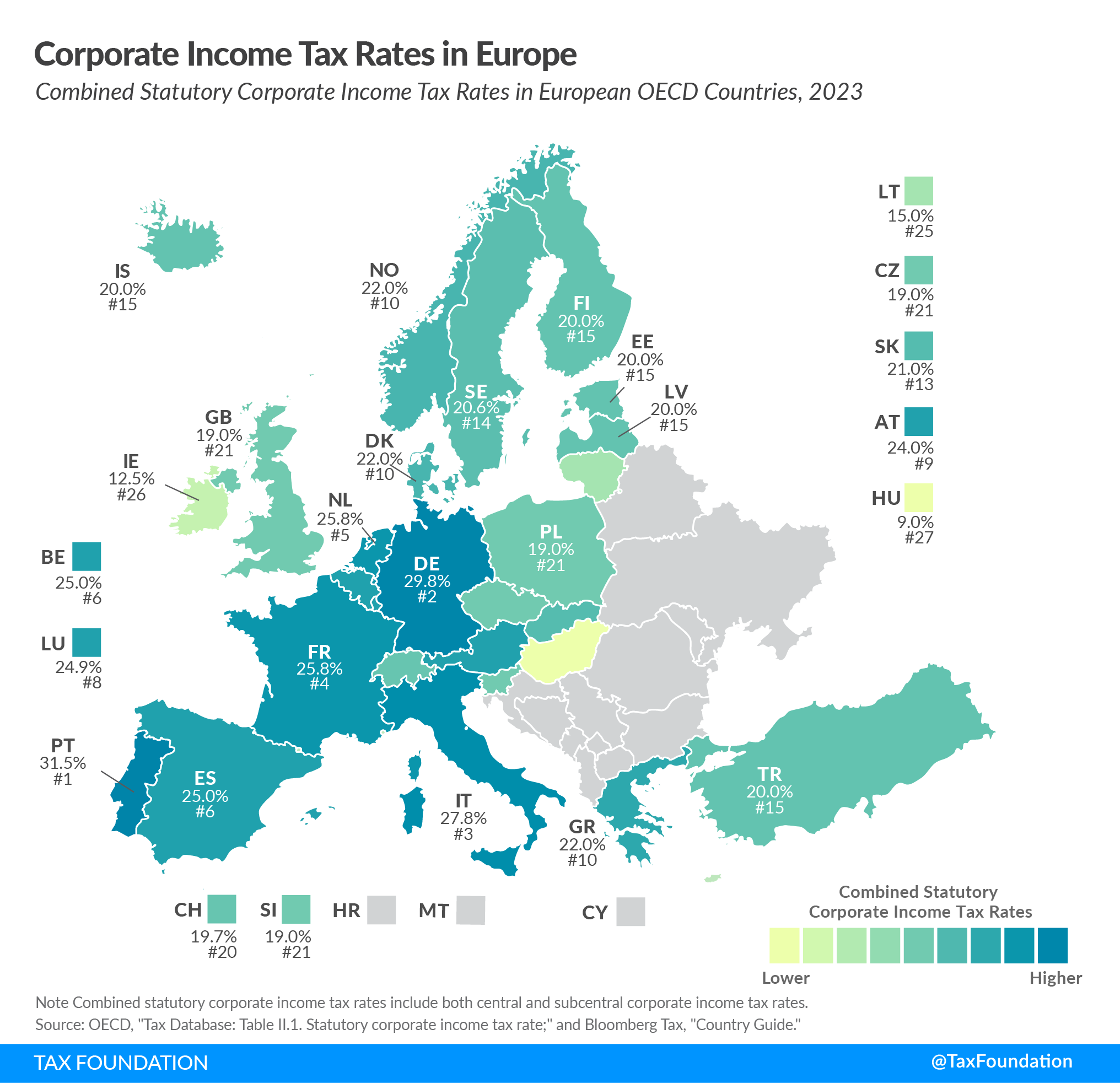
Corporate Income Tax Rates in Europe, 2023
2 min readBy:European countries—like almost all countries around the world—require businesses to pay corporate income taxes on their profits. The amount of taxes a business ultimately pays on its profits depends on both the corporate tax baseThe tax base is the total amount of income, property, assets, consumption, transactions, or other economic activity subject to taxation by a tax authority. A narrow tax base is non-neutral and inefficient. A broad tax base reduces tax administration costs and allows more revenue to be raised at lower rates. and the corporate taxA tax is a mandatory payment or charge collected by local, state, and national governments from individuals or businesses to cover the costs of general government services, goods, and activities. rate. Today’s map shows how statutory corporate income tax rates compare across European OECD countries.
Taking into account central and subcentral taxes, Portugal has the highest statutory corporate income tax rate among European OECD countries, at 31.5 percent. Germany and Italy follow, at 29.8 percent and 27.8 percent, respectively. Hungary (9 percent), Ireland (12.5 percent), and Lithuania (15 percent) have the lowest corporate income taxA corporate income tax (CIT) is levied by federal and state governments on business profits. Many companies are not subject to the CIT because they are taxed as pass-through businesses, with income reportable under the individual income tax. rates.
On average, European OECD countries currently levy a corporate income tax rate of 21.5 percent. This is slightly below the worldwide average which, measured across 180 jurisdictions, was 23.4 percent in 2022.
European countries—like most regions around the world—have experienced a decline in corporate income tax rates over the past decades, but the average corporate income tax rate has leveled off in recent years. Of the 27 European countries, only the Netherlands increased its corporate income tax rate in the last year, a trend expected to hold steady as countries have more efficient tax types to turn towards.
| Combined Statutory Corporate Income Tax Rates in European OECD Countries, 2023 | |
|---|---|
| European OECD Country | Combined Statutory Corporate Income Tax Rate |
| Australia | 30.00 |
| Austria | 25.00 |
| Belgium | 25.00 |
| Canada | 26.21 |
| Chile | 10.00 |
| Colombia | 35.00 |
| Costa Rica | 30.00 |
| Czech Republic | 19.00 |
| Denmark | 22.00 |
| Estonia | 20.00 |
| Finland | 20.00 |
| France | 25.83 |
| Germany | 29.83 |
| Greece | 22.00 |
| Hungary | 9.00 |
| Iceland | 20.00 |
| Ireland | 12.50 |
| Israel | 23.00 |
| Italy | 27.81 |
| Japan | 29.74 |
| Korea | 27.50 |
| Latvia | 20.00 |
| Lithuania | 15.00 |
| Luxembourg | 24.94 |
| Mexico | 30.00 |
| Netherlands | 25.80 |
| New Zealand | 28.00 |
| Norway | 22.00 |
| Poland | 19.00 |
| Portugal | 31.50 |
| Slovak Republic | 21.00 |
| Slovenia | 19.00 |
| Spain | 25.00 |
| Sweden | 20.60 |
| Switzerland | 19.70 |
| Türkiye | 23.00 |
| United Kingdom | 19.00 |
| United States | 25.81 |
|
Note: Combined statutory corporate income tax rates include both central and subcentral corporate income tax rates. Source: OECD, “Tax Database: Table II.1. Statutory corporate income tax rate;” and Bloomberg Tax, “Country Guide.” |
|
Stay informed on the tax policies impacting you.
Subscribe to get insights from our trusted experts delivered straight to your inbox.
Subscribe





